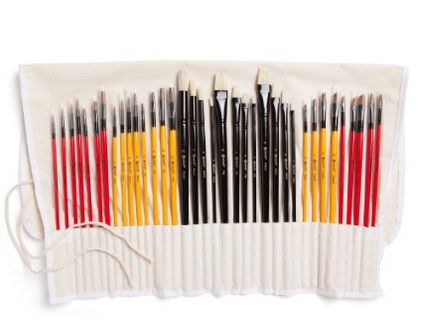Paintbrushes
There’s a dizzying assortment of brushes from which to choose and really it’s really a couple of preference about which ones to buy. Synthetic brushes are better for acrylic paints and Cryla brushes are great quality. Again, better to obtain a few quality brushes when compared to a whole load of cheap ones that shed most of their bristles onto the canvas. With that said some fairly cheap hog hair brushes are great for applying texture paste and scumbling.

The largest rule of thumb when working with acrylics just isn’t to allow the paint to dry on the brushes. Once dry they may be solid and although soaking them in methylated spirit overnight softens them a bit, many of them lose their shape so you wind up chucking them out.
Our recommendation is that portrait artists purchase a water container that permits the artist to relax the brushes on a ledge so the bristles are submerged in water minus the bristles being squashed. The artist then uses a rag or perhaps a piece of kitchen towel handy to remove any excess water once i next require to use that brush again. This protects needing to thoroughly rinse each brush after each use.
Brush techniques
Brushes must be damp although not wet if you are using the paint quite thickly as the paint’s own consistency can have enough flow. You can definitely you happen to be looking to use a watercolour technique your paint needs to be when combined lots of water.
Use a loil brushes as well as for better work use a thinner brush having a point. Retain the brush more detailed the bristles for increased accuracy or out-of-the-way if you would like more freedom with all the stroke. Start your portraits by holding a big brush halfway around quickly provide background a colour. Artists really should not be so focused on mixing the exact colour as they can often mix colours on the canvas by moving my brush around in several different directions.
One method to a family event portrait artists is always to start the eye using Payne’s Gray to fill out the shadows before using a fairly opaque background of flesh tint if the shadows have dried. And then build up the skin tone with lots of coloured washes and glazes.
Two various methods could possibly be explored here from the portrait artist:
• Vary a big amount colour about the palette with plenty of water and put it on liberally to the canvas in sweeping movements to create a general tint.
• Or ‘scumbling’, which can be where your brush is fairly dry, loaded simply a quarter full and dragged over the surface in most different directions allowing the dry under painting to exhibit through.
Picture artists make use of the scrumbling technique a whole lot particularly when painting highlights and places where light hits skin like on the tip from the nose, top lip, forehead and cheeks. The scrubbing motion has a tendency to wreck fine brushes so don’t use anything but hog hair brushes just for this.
Most of the family portrait is made up using glazes of different colours. The portrait’s appearance can alter quite dramatically at different stages leaving subjects looking seasick, jaundiced, embarrassed or like they’ve seen a ghost and had a great deal of heavy nights out.
Search for subtle shades, like there’s often yellow and blue in the skin tones beneath the eyes, pink about the cheeks and beneath the nose, crimson red on lips and ears and greens and purples from the shadows about the neck and forehead.
Finally, use fine brushes for adding details like eyelashes. Enable if your rest your little finger on the canvas to steady your hands at this aspect stage. After all of this you’ll hopefully have a very family portrait seems lifelike and resembles the person or family you are hoping to capture on canvas!
Check out about paint brush kit just go to this useful website: read more
